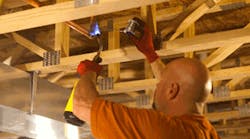ST. LOUIS, MO. – When people hear about business deals being struck on the golf course what usually comes to mind are multi-nationals, high-finance, and billions of dollars changing hands. But a friendly round of golf can lead to opportunities no matter what the size or scope of your business, and for Scott Usher, Field Superintendent for Fire Protection Systems, it lead to a partnership that has since installed sprinkler systems in 23 single-family homes, with plans to install sprinklers in another seven more.
“Almost two years ago, one of our venders held an annual charitable golf tournament,” Usher said, “and we were teamed up with a pair of first day employees of Habitat for Humanity. We were about three months prior to the adoption of the code that allowed sprinklers to be installed in homes in Missouri… so we got a dialogue going on, and in the course of a year’s time, we decided to donate sprinkler systems for 30 homes in two communities being built by habitat for humanity.”
Fire Protection Services has been in operation since 1976, and under its current owner and president, Stanley Shiner for the past 14 years. All they do is sprinkler work and up until now all that work has been commercial and industrial. In exploring the residential market they ran into trouble trying to get an answer to the most elementary question: how much does it actually cost to put sprinklers in a house?
“There are so many people here in the state of Missouri who do not want sprinklers,” Usher said. Much of the pushback came from the local Homebuilders Association, who were afraid of the impact sprinkler systems would have on their bottom line.
The Habitat for Humanity project was a chance for Fire Protection Systems not only to give back to the community, but also to collect some hard data that could later be turned into new business. And to spearhead the effort, Shiner could not have picked a person better suited to the job than Scott Usher, a 25-year employee who spent his first 17 years as a sprinkler fitter before being moved into the office.
Usher also works as an instructor at his union’s training center. Usher recruited most of his volunteer labor force out of his union, Local 268.
“I’d say 90% of all sprinkler work in this region of Missouri and Illinois is taken care of by fitters out of this local,” Usher says. “We have 115 years of tradition, and we have a good feel on the local market here.”
Local 268 was also instrumental in donating materials for the work, with additional help from the Copper Development Association, Cerro Copper, Viking Fire Sprinklers and other local companies. Copper piping was chosen over stainless steel (which is also approved for this type of construction) for its durability, slimmer profile and near limitless recyclability.
The first 17 houses Usher and his team tackled had already been constructed, which meant that there was no contractor to work with.
“Typically, we’re used to working with a contractor,” Usher said, “and we didn’t have one. That meant organizing everything ourselves. That made it a real commitment.”
Other problems came from bureaucratic issues with the City of St. Louis, including long lead times on approval for projects. Apart from the paperwork and the logistics, the installation itself was straightforward. Flexible, rolled K copper pipe is run from a tapping valve provided by the city, inch-and-a-half service, and is run up to the property line where the property line shut-off valve is. From there it switches to plastic pipe and the plastic pipe is run into the home. Once inside the home, the installers switch back to copper pipe again.
“With lightweight construction materials,” Usher explains, “you’re not allowed to use exposed CPVC. It has to be concealed above a fire-rated plenum, and these homes aren’t built that way.”
All-copper is run in the basement, and then the installers stub-up and catch the heads on the upstairs floor, at which point the installation is above a fire-rated plenum.
“When we go upstairs we convert back over to plastic,” Usher explained, “then we use CPVC fittings as part of a Blazemaster, fire-rated CPVC system.” Usher likes the versatility of the Blazemaster system. “Say you’ve got 2x4 studs with 5/8-in. drywall? They make a fitting where you can screw the head right on to that, perfectly to the wall where you can put the beauty ring on.”
Sprinkler heads donated by Viking were used to complete the installation. Because all the labor is donated, probably the highest cost associated with the project was the copper. Usher and Local 268 were able to purchase copper pipe at cost from Cerro Copper through a local vendor, with some of the final cost defrayed by donations from the Copper Development Association.
Work began on the project early last summer, and there remain seven homes to finish, which have just had their foundations poured. Usher will of course have to wait until the mechanical systems are installed, but is confident that once they are, he and his team will only need two or three weekends worth of effort to finish. In the meantime, he has been an observer of the Habitat for Humanity system for the past several months, and has nothing but admiration.
“They have a 95% success rate with getting people and keeping them in their new homes,” Usher said. “The [applicants] go through about two years of trial and tribulation… they have to maintain a job, maintain a bank account, balance their budgets, put sweat equity into their house, a lot of work. It isn’t like someone just turns around and hands them a set of keys. The people living in the homes were there on the weekends helping us. It’s a pretty neat experience. The whole organization is a pretty easy group to help.”
And the resulting homes are built to a high standard of quality by anyone’s measure. All 30 are pending LEED Platinum certification. They are equipped with tankless water heaters, geothermal exchange heating and cooling systems, structurally insulated panels, white TPO roofs, low VOC paints and incorporate recycled and sustainable building materials.
“The efficiency is just incredible,” Usher said. “They have an R-39 factor… I think the average utility bill is something like $60 or $70 [a month].”
The new homeowners have even started to have a visible impact on an area that has seen some especially hard times during the recent recession.
“You go to these neighborhoods that have just been through hell and back,” Usher said, “and you see them starting to turn the corner… a few years ago I was scared to even go to some of these places. Now, people are living there, kids are playing out there. Trying to get things straightened out.”
Related Articles:
Residential fire sprinkler battle continues: now states decide
Related Articles:
Residential fire sprinklers are also green




